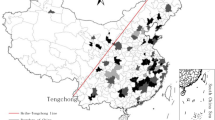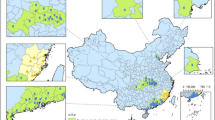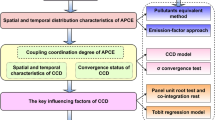Abstract
Collaborative reduction of carbon and air pollutants can more efficiently achieve green technological change, industrial low-carbon transition, and high-quality economic and social development. As a typical environmental policy in China, the pilot carbon Emission Trading Scheme (ETS) has obvious advantages in achieving the collaborative reduction of carbon and air pollutants. Therefore, an evaluation of China’s pilot carbon ETS from the perspective of collaborative reduction of carbon and air pollutants is performed in this paper. Compared with previous studies, first, this study innovatively uses the coupled coordination degree (CCD) model to measure the collaborative reduction level of carbon and air pollutants under different scenarios based on the panel data of China’s 30 provincial-level regions during 2004–2018. Second, this study uses the DID method to evaluate the impact of China’s pilot carbon ETS on the collaborative reduction of carbon and air pollutants and conducts some robustness checks and regional heterogeneity regressions. Third, this study uses the synthetic control method (SCM) further to examine the policy outcomes of the pilot carbon ETS. Scenario analysis shows that attaching importance to reducing air pollution will improve the collaborative reduction effect of carbon and air pollutants. Furthermore, the implementation of China’s pilot carbon ETS exerts an effect of roughly 24.7% on reducing carbon, roughly 10.1% on reducing air pollutants, and roughly 22.0% on the collaborative reduction of carbon and air pollutants, ceteris paribus. Regional heterogeneity analysis shows that the impacts of the pilot carbon ETS are significant in all regions, except that the impact on reducing air pollutants in the central region is not significant. In addition, results from SCM indicate that the impacts of the pilot carbon ETS on the collaborative reduction of carbon and air pollutants are significantly efficient in Beijing, Tianjin, Shanghai, Hubei, and Chongqing, while not much efficient in Guangdong and Fujian. The main policy implications include strengthening the top-level design of the ETS in the collaborative reduction of carbon and air pollutants, attaching importance to the governance of air pollution, making the regional governance more targeted, and improving energy efficiency.









Similar content being viewed by others
Change history
28 December 2022
A Correction to this paper has been published: https://doi.org/10.1007/s11356-022-25009-x
References
Abadie A, Gardeazabal J (2003) The economic costs of conflict: a case study of the Basque country. Am Econ Rev 93(1):113–132. https://doi.org/10.2139/ssrn.293120
Abadie A, Diamond A, Hainmueller J (2010) Synthetic control methods for comparative case studies: estimating the effect of California’s tobacco control program. J Am Stat Assoc 105(490):493–505. https://doi.org/10.1198/jasa.2009.ap08746
Chen X, Lin B (2021) Towards carbon neutrality by implementing carbon emissions trading scheme: policy evaluation in China. Energy Policy 157:112510. https://doi.org/10.1016/j.enpol.2021.112510
Cheng B, Dai H, Wang P, Zhao D, Masui T (2015) Impacts of carbon trading scheme on air pollutant emissions in Guangdong province of China. Energy Sustain Dev 27:174–185. https://doi.org/10.1016/j.esd.2015.06.001
Cheng Z, Li L, Liu J, Zhang H (2018) Total-factor carbon emission efficiency of China’s provincial industrial sector and its dynamic evolution. Renew Sustain Energy Rev 94:330–339. https://doi.org/10.1016/j.rser.2018.06.015
Coase R (1960) The problem of social cost. J Law Econ 3: 1–44. https://www.jstor.org/stable/724810. Accessed May 2022
Cong RG, Wei YM (2010) Potential impact of (CET) carbon emissions trading on China’s power sector: a perspective from different allowance allocation options. Energy 35(9):3921–3931. https://doi.org/10.1016/j.energy.2010.06.013
Dales JH (1968) Pollution, property & prices: an essay in policy-making and economics. University of Toronto Press, Toronto, 10–12. https://agris.fao.org/agris-search/search.do?recordID=US201300589613. Accessed May 2022
Ding G, Deng Y, Lin S (2019) A study on the classification of China’s provincial carbon emissions trading policy instruments: taking Fujian province as an example. Energy Rep 5:1543–1550. https://doi.org/10.1016/j.egyr.2019.10.010
Dong Z, Xia C, Fang K, Zhang W (2022) Effect of the carbon emissions trading policy on the co-benefits of carbon emissions reduction and air pollution control. Energy Policy 165:112998. https://doi.org/10.1016/j.enpol.2022.112998
Duan M, Pang T, Zhang X (2014) Review of carbon emissions trading pilots in China. Energy Environ 25(3–4):527–549. https://doi.org/10.1260/0958-305X.25.3-4.527
Fang K, Zhang Q, Song J, Yu C, Zhang H, Liu H (2021) How can national ETS affect carbon emissions and abatement costs? Evidence from the dual goals proposed by China’s NDCs. Resour Conserv Recycl 171:105638. https://doi.org/10.1016/j.resconrec.2021.105638
Fei J, Lin Y, Jiang Q, Jiang K, Li P, Ye G (2021) Spatiotemporal coupling coordination measurement on islands’ economy-environment-tourism system. Ocean Coast Manag 212:105793. https://doi.org/10.1016/j.ocecoaman.2021.105793
Fu L, Yi Y, Wu T, Cheng R, Zhang Z (2022) Do carbon emission trading scheme policies induce green technology innovation? New evidence from provincial green patents in China. Environ Sci Pollut Res. https://doi.org/10.1007/s11356-022-22877-1
Guo Q, Su Z, Chiao C (2021) Carbon emissions trading policy, carbon finance, and carbon emissions reduction: evidence from a quasi-natural experiment in China. Econ Chang Restruct. https://doi.org/10.1007/s10644-021-09353-5
Hanaoka T, Masui T (2020) Exploring effective short-lived climate pollutant mitigation scenarios by considering synergies and trade-offs of combinations of air pollutant measures and low carbon measures towards the level of the 2℃ target in Asia. Environ Pollut 261:113650. https://doi.org/10.1016/j.envpol.2019.113650
Hong Q, Cui L, Hong P (2022) The impact of carbon emissions trading on energy efficiency: evidence from quasi-experiment in China’s carbon emissions trading pilot. Energy Econ 110:106025. https://doi.org/10.1016/j.eneco.2022.106025
Huang Z, Du X (2020) Toward green development? Impact of the carbon emissions trading system on local governments’ land supply in energy-intensive industries in China. Sci Total Environ 738:139769. https://doi.org/10.1016/j.scitotenv.2020.139769
IEA (2022) Global energy review: CO2 emissions in 2021. International Energy Agency. https://www.iea.org/reports/global-energy-review-co2-emissions-in-2021-2. Accessed March 2022
Jia S, Yang C, Wang M, Failler P (2022) Heterogeneous impact of land-use on climate change: study from a spatial perspective. Front Environ Sci 10:840603. https://doi.org/10.3389/fenvs.2022.840603
Jiang P, Khishgee S, Alimujiang A, Dong H (2020) Cost-effective approaches for reducing carbon and air pollution emissions in the power industry in China. J Environ Manag 264:110452. https://doi.org/10.1016/j.jenvman.2020.110452
Kang Y, Liao S, Jiang C, D’Alfonso T (2022) Synthetic control methods for policy analysis: evaluating the effect of the European Emission Trading System on aviation supply. Transport Res Part A-Policy Pract 162:236–252. https://doi.org/10.1016/j.tra.2022.05.015
Kou P, Han Y, Qi X, Li Y (2022) Does China’s policy of carbon emission trading deliver sulfur dioxide reduction co-benefits? Environ Dev Sustain 24(5):6224–6245. https://doi.org/10.1007/s10668-021-01699-0
Li J, Huang X (2020) Impact of land-cover layout on particulate matter 2.5 in urban areas of China. Int J Digit Earth 13(4):474–486. https://doi.org/10.1080/17538947.2018.1530310
Li Y, Yi L, Yan Z, Shi Y, Zhu X (2012) Investigation of a coupling model of coordination between urbanization and the environment. J Environ Manage 98:127–133. https://doi.org/10.1016/j.jenvman.2011.12.025
Lin B, Huang C (2022) Analysis of emission reduction effects of carbon trading: market mechanism or government intervention? Sustain Prod Consum 33:28–37. https://doi.org/10.1016/j.spc.2022.06.016
Lin H, Jiang P (2022) Analyzing the phased changes of socioeconomic drivers to carbon dioxide and particulate matter emissions in the Yangtze River Delta. Ecol Ind 140:109044. https://doi.org/10.1016/j.ecolind.2022.109044
Lin Y, Yang X, Li Y, Yao S (2020) The effect of forest on PM2.5 concentrations: a spatial panel approach. Forest Policy Econ 118:102261. https://doi.org/10.1016/j.forpol.2020.102261
Liu L, Chen C, Zhao Y, Zhao E (2015) China’s carbon-emissions trading: overview, challenges and future. Renew Sustain Energy Rev 49:254–266. https://doi.org/10.1016/j.rser.2015.04.076
Liu JY, Woodward RT, Zhang YJ (2021a) Has carbon emissions trading reduced PM2.5 in China? Environ Sci Technol 55:6631–6643. https://doi.org/10.1021/acs.est.1c00248
Liu P, Zhang L, Tarbert H, Yan Z (2021b) Analysis on spatio-temporal characteristics and influencing factors of industrial green innovation efficiency - from the perspective of innovation value chain. Sustainability 14(1):342. https://doi.org/10.3390/su14010342
Liu C, Xin L, Li J, Sun H (2022) The impact of renewable energy technology innovation on industrial green transformation and upgrading: beggar thy neighbor or benefiting thy neighbor. Sustainability 14(18):11198. https://doi.org/10.3390/su141811198
Lv M, Bai M (2021) Evaluation of China’s carbon emission trading policy from corporate innovation. Financ Res Lett 39:101565. https://doi.org/10.1016/j.frl.2020.101565
Mo JL, Agnolucci P, Jiang MR, Fan Y (2016) The impact of the Chinese carbon emission trading scheme (ETS) on low carbon energy (LCE) investment. Energy Policy 89:271–283. https://doi.org/10.1016/j.enpol.2015.12.002
Monjardino J, Dias L, Fortes P, Tente H, Seixas J (2021) Carbon neutrality pathways effects on air pollutant emissions: the Portuguese case. Atmosphere 12(3):324. https://doi.org/10.3390/atmos12030324
Nie X, Wu J, Zhang W, Zhang J, Wang W, Wang Y, Luo Y, Wang H (2021) Can environmental regulation promote urban innovation in the underdeveloped coastal regions of western China? Mar Policy 133:104709. https://doi.org/10.1016/j.marpol.2021.104709
Pan X, Pu C, Yuan S, Xu H (2022) Effect of Chinese pilots carbon emission trading scheme on enterprises’ total factor productivity: the moderating role of government participation and carbon trading market efficiency. J Environ Manage 316:115228. https://doi.org/10.1016/j.jenvman.2022.115228
Pigou A (1951) Some aspects of welfare economics. Am Econ Rev 41(3): 287–302. https://www.jstor.org/stable/1802103. Accessed May 2022
Qi Y, Farnoosh A, Lin L, Liu H (2022) Coupling coordination analysis of China’s provincial water-energy-food nexus. Environ Sci Pollut Res 29(16):23303–23313. https://doi.org/10.1007/s11356-021-17036-x
Rosenbaum PR, Rubin DB (1983) The central role of the propensity score in observational studies for causal effects. Biometrika 70(1):41–55. https://doi.org/10.1093/biomet/70.1.41
Ruehli EA (1974) Equivalent circuit models for three-dimensional multiconductor systems. IEEE Trans Microw Theory Tech 22(3):216–221. https://doi.org/10.1109/TMTT.1974.1128204
Schleussner CF, Rogelj J, Schaeffer M, Lissner T, Licker R, Fischer EM, Knutti R, Levermann A, Frieler K, Hare W (2016) Science and policy characteristics of the Paris Agreement temperature goal. Nat Clim Chang 6(9):827–835. https://doi.org/10.1038/NCLIMATE3096
Shi X, Xu Y (2022) Evaluation of China’s pilot low-carbon city program: a perspective of industrial carbon emission efficiency. Atmos Pollut Res 13(6):101446. https://doi.org/10.1016/j.apr.2022.101446
Skjaerseth JB, Wettestad J (2008) Implementing EU emissions trading: success or failure? Int Environ Agreements - Polit Law Econ 8(3):275–290. https://doi.org/10.1007/s10784-008-9068-4
Song J, Chen R, Ma X (2021) Collaborative allocation of energy consumption, air pollutants and CO2 emissions in China. Sustainability 13(16):9443. https://doi.org/10.3390/su13169443
Stuhlmacher M, Patnaik S, Streletskiy D, Taylor K (2019) Cap-and-trade and emissions clustering: a spatial-temporal analysis of the European Union Emissions Trading Scheme. J Environ Manag 249:109352. https://doi.org/10.1016/j.jenvman.2019.109352
Suk S, Lee S, Jeong YS (2018) The Korean emissions trading scheme: business perspectives on the early years of operations. Clim Policy 18(6):715–728. https://doi.org/10.1080/14693062.2017.1346499
Wang K, Miao Z, Zhao M, Miao C, Wang Q (2019) China’s provincial total-factor air pollution emission efficiency evaluation, dynamic evolution and influencing factors. Ecol Ind 107:105578. https://doi.org/10.1016/j.ecolind.2019.105578
Wang L, Chen H, Chen W (2020) Co-control of carbon dioxide and air pollutant emissions in China from a cost-effective perspective. Mitig Adapt Strat Glob Change 25:1177–1197. https://doi.org/10.1007/s11027-019-09872-7
Wang B, Wang Y, Zhao Y (2021) Collaborative governance mechanism of climate change and air pollution: evidence from China. Sustainability 13(12):6785. https://doi.org/10.3390/su13126785
Wang X, Huang J, Liu H (2022) Can China’s carbon trading policy help achieve Carbon Neutrality? - A study of policy effects from the Five-sphere Integrated Plan perspective. J Environ Manag 305:114357. https://doi.org/10.1016/j.jenvman.2021.114357
Watanabe R, Robinson G (2005) The European Union emissions trading scheme (EU ETS). Clim Policy 5(1):10–14. https://doi.org/10.1080/14693062.2005.9685537
Wu R, Dai H, Geng Y, Xie Y, Mosui T, Tian X (2016) Achieving China’s INDC through carbon cap-and-trade: insights from Shanghai. Appl Energy 184:1114–1122. https://doi.org/10.1016/j.apenergy.2016.06.011
Xin L, Sun H, Xia X, Wang H, Xiao H, Yan X (2022) How does renewable energy technology innovation affect manufacturing carbon intensity in China? Environ Sci Pollut Res 29(39):59784–59801. https://doi.org/10.1007/s11356-022-20012-8
Xu S, Yang C, Huang Z, Failler P (2022) Interaction between digital economy and environmental pollution: new evidence from a spatial perspective. Int J Environ Res Public Health 19:5074. https://doi.org/10.3390/ijerph19095074
Yang C, Zeng W, Yang X (2020a) Coupling coordination evaluation and sustainable development pattern of geo-ecological environment and urbanization in Chongqing municipality, Chins. Sustain Cities Soc 61:102271. https://doi.org/10.1016/j.scs.2020.102271
Yang X, Jiang P, Pan Y (2020b) Does China’s carbon emission trading policy have an employment double dividend and a porter effect? Energy Policy 142:111492. https://doi.org/10.1016/j.enpol.2020.111492
Yang L, Li Y, Liu H (2021a) Did carbon trade improve green production performance? Evidence from China. Energy Econ 96:105185. https://doi.org/10.1016/j.eneco.2021.105185
Yang X, Wang W, Wu H, Wang J, Ran Q, Ren S (2021b) The impact of the new energy demonstration city policy on the green total factor productivity of resource-based cities: empirical evidence from a quasi-natural experiment in China. J Environ Planning Manag. https://doi.org/10.1080/09640568.2021.1988529
Yang X, Wang W, Su X, Ren S, Ran Q, Wang J, Cao J (2022) Analysis of the influence of land finance on haze pollution: an empirical study based on 269 prefecture-level cities in China. Growth Chang. https://doi.org/10.1111/grow.12638
Zhang G, Zhang N (2020) The effect of China’s pilot carbon emissions trading schemes on poverty alleviation: a quasi-natural experiment approach. J Environ Manag 271:110973. https://doi.org/10.1016/j.jenvman.2020.110973
Zhang H, Ma X, Han G, Xu H, Shi T, Zhong W, Gong W (2021) Study on collaborative emission reduction in green-house and pollutant gas due to COVID-19 lockdown in China. Remote Sens 13(17):3492. https://doi.org/10.3390/rs13173492
Zhang W, Li G, Guo F (2022a) Does carbon emissions trading promote green technology innovation in China? Appl Energy 315:119012. https://doi.org/10.1016/j.apenergy.2022.119012
Zhang X, Lu F, Xue D (2022b) Does China’s carbon emission trading policy improve regional energy efficiency? - an analysis based on quasi-experimental and policy spillover effects. Environ Sci Pollut Res 29(14):21166–21183. https://doi.org/10.1007/s11356-021-17021-4
Zhang Y, Qi L, Lin X, Pan H, Sharp B (2022c) Synergistic effect of carbon ETS and carbon tax under China’s peak emission target: a dynamic CGE analysis. Sci Total Environ 825:154076. https://doi.org/10.1016/j.scitotenv.2022.154076
Zhao S, Cao Y, Feng C, Guo K, Zhang J (2022) How do heterogeneous R&D investments affect China’s green productivity: revisiting the Porter hypothesis. Sci Total Environ 825:154090. https://doi.org/10.1016/j.scitotenv.2022.154090
Zhou D, Zhang X, Wang X (2020) Research on coupling degree and coupling path between China’s carbon emission efficiency and industrial structure upgrading. Environ Sci Pollut Res 27(20):25149–25162. https://doi.org/10.1007/s11356-020-08993-w
Funding
The authors gratefully acknowledge the financial support from the National Social Science Fund of China (No. 20BJL144), the Social Science Fund of Jiangsu Province (No. 21ZD005), the China Scholarship Council (No. 202106095003), and the Postgraduate Research & Practice Innovation Program of Jiangsu Province (NO. KYCX22_0251).
Author information
Authors and Affiliations
Contributions
Xiuyi Shi: writing—original draft, conceptualization, methodology, data curation, software, visualization, validation, funding acquisition; Yingzhi Xu: resources, project administration, funding acquisition, writing – review and editing, supervision; Wenyuan Sun: funding acquisition, supervision.
Corresponding author
Ethics declarations
Ethics approval
Not applicable
Consent to participate
Not applicable
Consent for publication
Not applicable
Competing interests
The authors declare no competing interests.
Additional information
Responsible Editor: Eyup Dogan
Publisher's note
Springer Nature remains neutral with regard to jurisdictional claims in published maps and institutional affiliations.
Rights and permissions
Springer Nature or its licensor (e.g. a society or other partner) holds exclusive rights to this article under a publishing agreement with the author(s) or other rightsholder(s); author self-archiving of the accepted manuscript version of this article is solely governed by the terms of such publishing agreement and applicable law.
About this article
Cite this article
Shi, X., Xu, Y. & Sun, W. Evaluating China’s pilot carbon Emission Trading Scheme: collaborative reduction of carbon and air pollutants. Environ Sci Pollut Res 31, 10086–10105 (2024). https://doi.org/10.1007/s11356-022-24685-z
Received:
Accepted:
Published:
Issue Date:
DOI: https://doi.org/10.1007/s11356-022-24685-z




